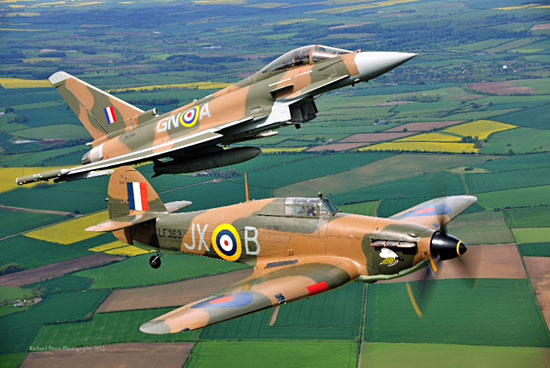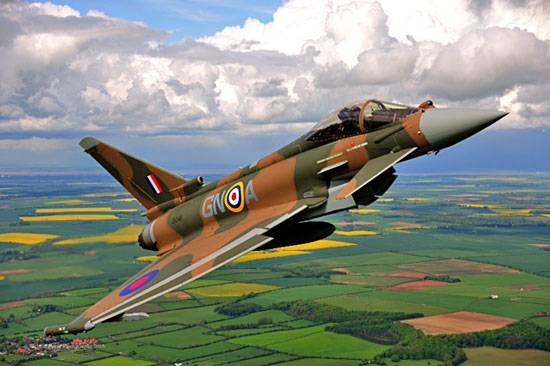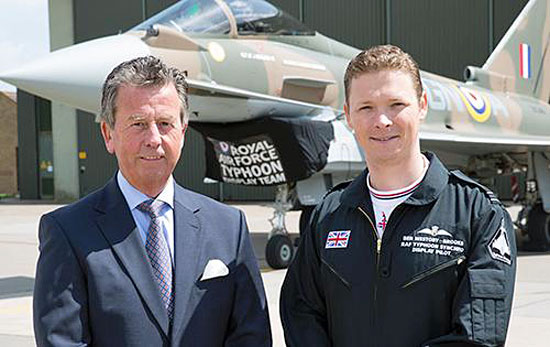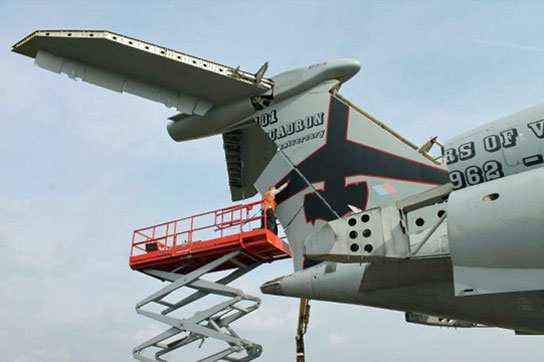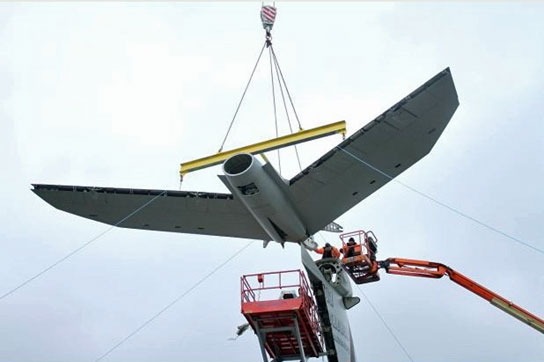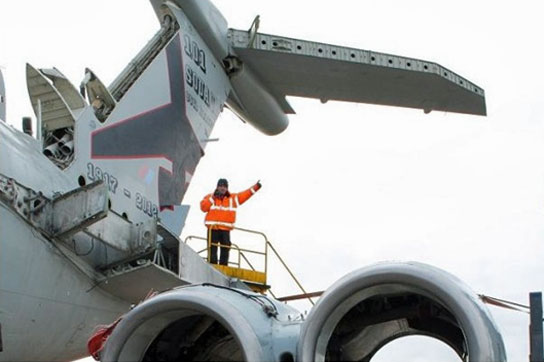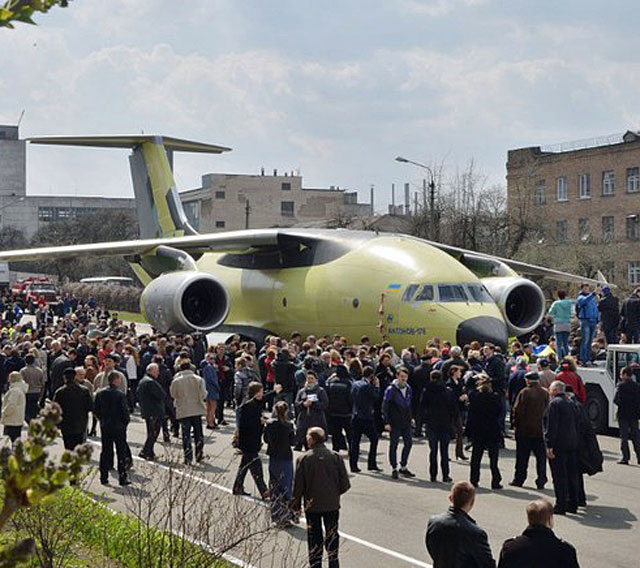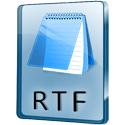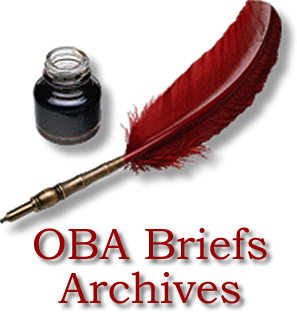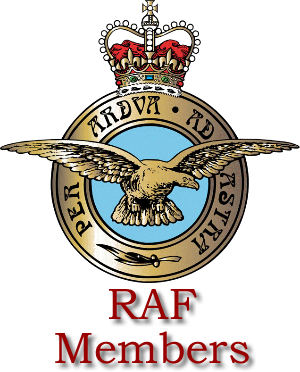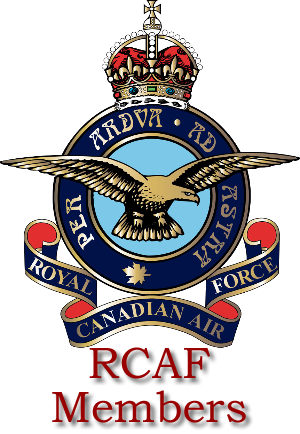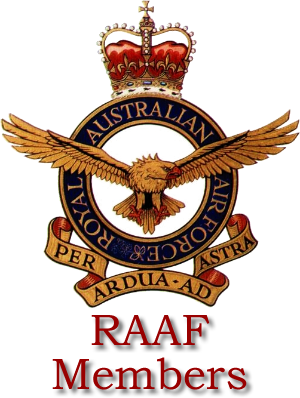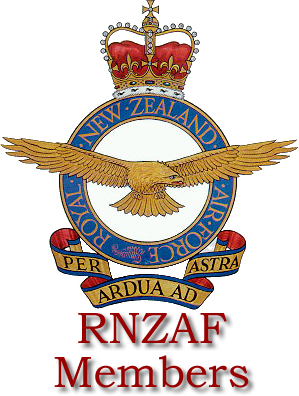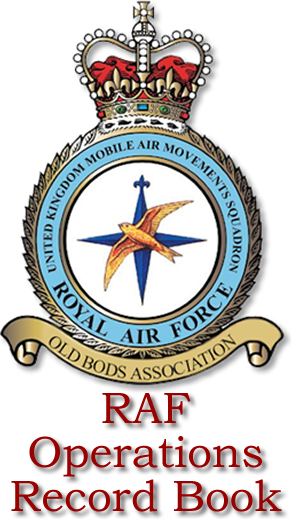
Software Bug May Have Caused Airbus A400M Atlas Crash
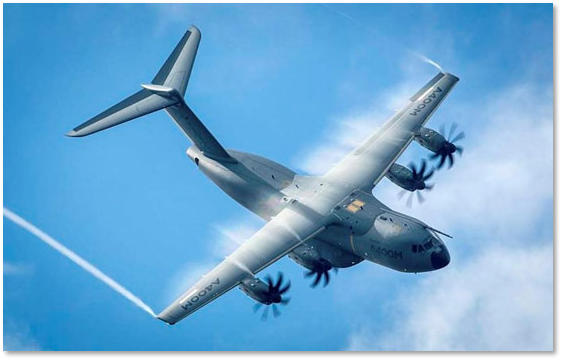
Early indications suggest that a software bug may have been the cause of the Airbus A400M Atlas crash in Spain on the 9th of May.
Airbus has sent an alert to customers, including the RAF, instructing them to conduct "specific checks of the Electronic Control Units (ECU) on each of the aircraft's engines".
The ECUs act to take the pilot's inputs on the controls and then make the engines perform in the optimum way in order to achieve what the pilot needs the aircraft to do.
According to the German news organisation Spiegel the Seville crash occured after three engines shut down upon receiving "contradictory instructions" from the flight control system.
The crew attempted to nurse the aircraft, which was undergoing testing ahead of delivery to the Turkish military, back to the airport but collided with a pylon. Four of the six people aboard died in the resulting fireball.
Airbus has sent an alert to customers, including the RAF, instructing them to conduct "specific checks of the Electronic Control Units (ECU) on each of the aircraft's engines".
The ECUs act to take the pilot's inputs on the controls and then make the engines perform in the optimum way in order to achieve what the pilot needs the aircraft to do.
According to the German news organisation Spiegel the Seville crash occured after three engines shut down upon receiving "contradictory instructions" from the flight control system.
The crew attempted to nurse the aircraft, which was undergoing testing ahead of delivery to the Turkish military, back to the airport but collided with a pylon. Four of the six people aboard died in the resulting fireball.
The A400M is the RAF's newest aircraft, having taken delivery of the first plane 'The City of Bristol' in 2014. It didn't however carry its first operational payload until March of this year.
A further 21 of the tactical airlifters are scheduled for delivery by 2019. They'll operate out of RAF Brize Norton and replace the ageing C-130 Hercules fleet which is due to be retired in 2022.
The Ministry of Defence suspended flights of the RAF's A400M Atlas aircraft following the disaster.
Forces TV
A further 21 of the tactical airlifters are scheduled for delivery by 2019. They'll operate out of RAF Brize Norton and replace the ageing C-130 Hercules fleet which is due to be retired in 2022.
The Ministry of Defence suspended flights of the RAF's A400M Atlas aircraft following the disaster.
Forces TV
From: Thomas Geoghegan, Folkestone, Kent
Sent: Friday, April 24, 2015 6:34 AM
Subject: Re: UKMAMS OBA OBB #042515
Hi again Tony,
Got to comment on your latest newsletter; first item really flabbergasted me [RAF Voyager ZZ333 plunge final report: 33 injured]. I cannot believe that both these aircrew could be so stupid as to endanger the lives of so many passengers and crew. Can this be the calibre of aircrew flying the most modern of aircraft in the skies be Royal Air Force aircrew so respected by we earth bound erks in former years?
As a civvie, up to 9/11, I flew with my airline whenever possible and usually on the flight deck. I can gladly relate that I have never been anything but greatly impressed with their professionalism. One of my last flights, from Edinburgh to Gatwick, was under the control of a twenty-year-old first officer whom I can honestly say preformed the best landing ever.
To be absent from the flight deck for much longer than necessary is really out of order and the bored and under aroused bit, some excuse. Are there no attractive stewardesses available to sit in the empty seat while one or the other crew member is absent?
I can categorically state that if this incident occurred in a civilian airline, the pilots would be brought before the CAA and most likely sacked.
Lastly, I feel so sorry for the injured, some of whom may never fly again, and also for the good name of the Royal Air Force.
Kindest Regards,
Tod Geoghegan
Sent: Friday, April 24, 2015 6:34 AM
Subject: Re: UKMAMS OBA OBB #042515
Hi again Tony,
Got to comment on your latest newsletter; first item really flabbergasted me [RAF Voyager ZZ333 plunge final report: 33 injured]. I cannot believe that both these aircrew could be so stupid as to endanger the lives of so many passengers and crew. Can this be the calibre of aircrew flying the most modern of aircraft in the skies be Royal Air Force aircrew so respected by we earth bound erks in former years?
As a civvie, up to 9/11, I flew with my airline whenever possible and usually on the flight deck. I can gladly relate that I have never been anything but greatly impressed with their professionalism. One of my last flights, from Edinburgh to Gatwick, was under the control of a twenty-year-old first officer whom I can honestly say preformed the best landing ever.
To be absent from the flight deck for much longer than necessary is really out of order and the bored and under aroused bit, some excuse. Are there no attractive stewardesses available to sit in the empty seat while one or the other crew member is absent?
I can categorically state that if this incident occurred in a civilian airline, the pilots would be brought before the CAA and most likely sacked.
Lastly, I feel so sorry for the injured, some of whom may never fly again, and also for the good name of the Royal Air Force.
Kindest Regards,
Tod Geoghegan
RAF Unveils VC “Battle Of Britain” Typhoon
The RAF today unveiled at RAF Coningsby, Lincolnshire a state-of-the art Typhoon fighter jet in a Battle of Britain era paint scheme to commemorate this year being the 75th anniversary of the Battle of Britain and to acknowledge the bravery and sacrifice of those often referred to as “The Few”: the aircrew who took part in the battle. The Typhoon is also painted with the 249 Squadron identification number of the only Fighter Command pilot awarded a Victoria Cross during the battle: Flight Lieutenant James Brindley Nicolson VC DFC. The Typhoon along with a WWII Spitfire, as part of a Synchro-pair, will perform aerial displays at air shows across the UK this summer.
The Typhoon will be flown by Flight Lieutenant Ben Westoby-Brooks from Coningsby’s 29(R) Squadron; he said, “It is a great privilege to fly this extraordinary aircraft in recognition of the sacrifices made by our predecessors 75 years ago. Their task of securing the skies was critical in the summer of 1940 and it’s an honour to pay tribute to those few brave airmen who gave their all when the stakes were so high”.
The Typhoon will be flown by Flight Lieutenant Ben Westoby-Brooks from Coningsby’s 29(R) Squadron; he said, “It is a great privilege to fly this extraordinary aircraft in recognition of the sacrifices made by our predecessors 75 years ago. Their task of securing the skies was critical in the summer of 1940 and it’s an honour to pay tribute to those few brave airmen who gave their all when the stakes were so high”.
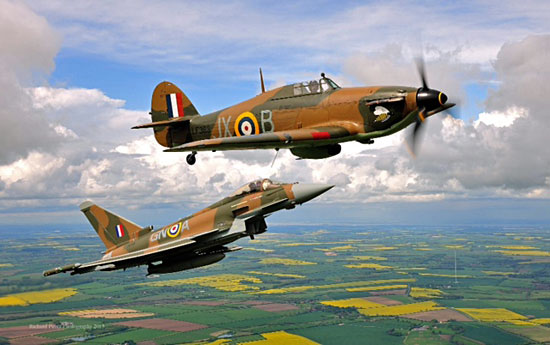
Present to see the unveiling was Flight Lieutenant Nicolson’s nephew, Mr Jim Nicolson, he said, “I’m so thrilled that the Royal Air Force has commemorated this aircraft the way they have. It just looks amazing. The plane is amazing anyway but to see it in those colours it is just fantastic and it is the icing on the cake for me.”
The Battle of Britain ranks alongside the battles of Trafalgar and Waterloo as one of the most significant in British history. It was the first strategic defeat suffered by the Nazi Third Reich during the Second World War. The victory by the RAF enabled the Western Allies to later launch the liberation of Western Europe and compel the Nazis to fight on two fronts leading to their consequent defeat.
The success of the RAF was due not just to the exceptional bravery and skill of the aircrews of Fighter Command but also those of Bomber and Coastal Commands and the many women of the Women’s Auxiliary Air Force who worked tirelessly to repulse the threat of invasion - the many who supported the few.
RAF Coningsby Station Commander, Group Captain Jez Attridge said, “This fully operational Typhoon will be a dynamic reminder to all that see it over the summer of the link between the modern Royal Air Force and The Few that defended our nation 75 years ago during the battle. Today that mission endures with Typhoons on Quick Reaction Alert, every minute of every day.” The RAF’s Quick Reaction Alert Typhoons defend the UK against potentially hostile aircraft approaching the UK sovereign airspace. Group Captain Attridge added: “The technology has changed since the Battle of Britain but the mission for the RAF to protect the UK remains unchanged”.
raf.mod.uk
The Battle of Britain ranks alongside the battles of Trafalgar and Waterloo as one of the most significant in British history. It was the first strategic defeat suffered by the Nazi Third Reich during the Second World War. The victory by the RAF enabled the Western Allies to later launch the liberation of Western Europe and compel the Nazis to fight on two fronts leading to their consequent defeat.
The success of the RAF was due not just to the exceptional bravery and skill of the aircrews of Fighter Command but also those of Bomber and Coastal Commands and the many women of the Women’s Auxiliary Air Force who worked tirelessly to repulse the threat of invasion - the many who supported the few.
RAF Coningsby Station Commander, Group Captain Jez Attridge said, “This fully operational Typhoon will be a dynamic reminder to all that see it over the summer of the link between the modern Royal Air Force and The Few that defended our nation 75 years ago during the battle. Today that mission endures with Typhoons on Quick Reaction Alert, every minute of every day.” The RAF’s Quick Reaction Alert Typhoons defend the UK against potentially hostile aircraft approaching the UK sovereign airspace. Group Captain Attridge added: “The technology has changed since the Battle of Britain but the mission for the RAF to protect the UK remains unchanged”.
raf.mod.uk
From: Roy Irish
Sent: Friday, April 24, 2015 9:11 AM
Subject: RE: UKMAMS OBA OBB #042515
Good afternoon, Tony.
Many thanks for the recent OBA Newsletter - fantastic, relevant material, as ever - each issue resulting in amazement at the efficiency of your “collection“ system!
I now ask for your help on one item in particular. I spotted a letter from one Allan Walker of Burnley, Lancs - who was helping to identify RAF Mystery photo 032715. In the mid 1980's, during my final posting in the RAF, I served with an Allan Walker at the MOD Harrogate, UK , and knew that he lived near Burnley. After keeping in touch for many years, I “lost” his address - and would like to regain that contact. Could you please let me have his email address - or - I would be grateful if you would pass mine on to him.
Thank you.
Roy Irish.
Sent: Friday, April 24, 2015 9:11 AM
Subject: RE: UKMAMS OBA OBB #042515
Good afternoon, Tony.
Many thanks for the recent OBA Newsletter - fantastic, relevant material, as ever - each issue resulting in amazement at the efficiency of your “collection“ system!
I now ask for your help on one item in particular. I spotted a letter from one Allan Walker of Burnley, Lancs - who was helping to identify RAF Mystery photo 032715. In the mid 1980's, during my final posting in the RAF, I served with an Allan Walker at the MOD Harrogate, UK , and knew that he lived near Burnley. After keeping in touch for many years, I “lost” his address - and would like to regain that contact. Could you please let me have his email address - or - I would be grateful if you would pass mine on to him.
Thank you.
Roy Irish.
From: Tony Gale, Gatineau, QC
Sent: 24 April 2015 17:28
To: 'Roy Irish'
Subject: RE: UKMAMS OBA OBB #042515 - Allan Walker
Hi Roy,
There are several ways to get Allan’s details from the OBA site:
Sent: 24 April 2015 17:28
To: 'Roy Irish'
Subject: RE: UKMAMS OBA OBB #042515 - Allan Walker
Hi Roy,
There are several ways to get Allan’s details from the OBA site:
•
Newsletter - The flags to the right of his name in the newsletter contain a link to his e-mail address - left click will open up a compose e-mail screen with his address already filled in - or - if you don’t have an on-board e-mail program, right click and copy the e-mail address to your clipboard.
•
The Member’s Pages - Go to http://ukmamsoba.org/members.htm then left click on the S-Z Crate at the top right. This will bring you to the page where Allan’s e-mail address and current telephone number are listed. The e-mail is hidden under his name in the penultimate column in order to defeat e-mail address harvesters (spammers).
•
OBA Earth - Again, located on the Member’s page http://ukmamsoba.org/members.htm left click on the OBA Earth map icon. This page basically works in the same way as Google Earth, but with a few added bonuses. In the top right you will see a Search Area. Put the name Allan Walker into the search area and you will be able to zoom into his home on the map - it also provides e-mail and telephone details. Some members have opted to put their street address in this listing, which provides a more accurate locale. Click on the magnifying glass in the information card and that will provide you with a closer look. By dragging the little orange man at the top left over the blue pin representing Allan’s location and releasing it, you’ll be able to get a street view fairly close to his home.
To make a comment in the vernacular, I would have to say, “Magic init?”
Best regards
Tony
Best regards
Tony
Upcoming Appointment of New CDS: LGen J.H. Vance, CMM, MSC, CD
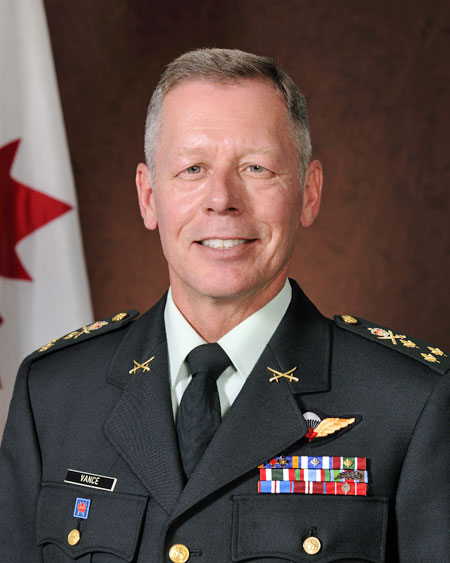
Lieutenant-General Vance joined the Canadian Forces in 1982 and was commissioned as an infantry officer into The Royal Canadian Regiment in 1986 following his graduation from Royal Roads Military College. Lieutenant-General Vance has served with the 1st, 2nd and 3rd Battalions, The Royal Canadian Regiment, and has commanded at all levels within the field force from platoon commander to brigade commander and as Joint Task Force Commander.
Most notably, Lieutenant-General Vance commanded the Second Battalion, The Royal Canadian Regiment in Gagetown, New Brunswick from 2001-2003. He also commanded 1 Canadian Mechanized Brigade Group in Edmonton from 2006 to 2008 and subsequently deployed as Commander Joint Task Force Afghanistan and Task Force Kandahar in 2009 and again in 2010.
Following his tour(s) in Afghanistan, Lieutenant-General Vance served on the Army Staff as Chief of Staff Land Strategy, and as Director of Staff, Strategic Joint Staff in National Defence Headquarters. He recently completed a tour as Deputy Commander, Allied Joint Force Command Naples in July 2014. He assumed his position as Commander Canadian Joint Operations Command in September 2014.
Lieutenant-General Vance is a graduate of the Canadian Forces Staff School, the UK Combined Arms Tactics Course, the Canadian Army Staff College, the Canadian Forces Command and Staff Course, the Advanced Military Studies Course and the Coalition Forces Land Component Command Course. He holds a Bachelor of Arts Degree in Military and Strategic Studies from Royal Roads Military College, and a Master of Arts Degree in War Studies from RMC. His decorations include the Order of Military Merit in the rank of Commander, the Meritorious Service Cross with bar and a Mentioned-in-Dispatches. In 2011, he was awarded the Vimy Award for his contributions to Canadian defence and security.
Most notably, Lieutenant-General Vance commanded the Second Battalion, The Royal Canadian Regiment in Gagetown, New Brunswick from 2001-2003. He also commanded 1 Canadian Mechanized Brigade Group in Edmonton from 2006 to 2008 and subsequently deployed as Commander Joint Task Force Afghanistan and Task Force Kandahar in 2009 and again in 2010.
Following his tour(s) in Afghanistan, Lieutenant-General Vance served on the Army Staff as Chief of Staff Land Strategy, and as Director of Staff, Strategic Joint Staff in National Defence Headquarters. He recently completed a tour as Deputy Commander, Allied Joint Force Command Naples in July 2014. He assumed his position as Commander Canadian Joint Operations Command in September 2014.
Lieutenant-General Vance is a graduate of the Canadian Forces Staff School, the UK Combined Arms Tactics Course, the Canadian Army Staff College, the Canadian Forces Command and Staff Course, the Advanced Military Studies Course and the Coalition Forces Land Component Command Course. He holds a Bachelor of Arts Degree in Military and Strategic Studies from Royal Roads Military College, and a Master of Arts Degree in War Studies from RMC. His decorations include the Order of Military Merit in the rank of Commander, the Meritorious Service Cross with bar and a Mentioned-in-Dispatches. In 2011, he was awarded the Vimy Award for his contributions to Canadian defence and security.
From: John R McGrath, Blackpool, Lancs
Sent: Sunday, April 26, 2015 4:19 AM
Subject: Aviano
Hi.
I have just read the article in the newsletter from Steve Bird. I was one of the Waddington Movers who helped set up the Aviano detachment in 1993. It was only meant to be a short term thing as part of Op Deny flight, a NATO op to keep the Serbs from using their helicopters to attack the Croats.
Steve Bishop Paul English and myself were at Waddington and would each spend a week or two at Aviano. This continued for a year or so until the task was given to Lyneham to man. The Americans couldn't be more helpful and Aviano was a great place to work. It was hard work at times but I really enjoyed my time out there.
Rgds to all
John McGrath
Sent: Sunday, April 26, 2015 4:19 AM
Subject: Aviano
Hi.
I have just read the article in the newsletter from Steve Bird. I was one of the Waddington Movers who helped set up the Aviano detachment in 1993. It was only meant to be a short term thing as part of Op Deny flight, a NATO op to keep the Serbs from using their helicopters to attack the Croats.
Steve Bishop Paul English and myself were at Waddington and would each spend a week or two at Aviano. This continued for a year or so until the task was given to Lyneham to man. The Americans couldn't be more helpful and Aviano was a great place to work. It was hard work at times but I really enjoyed my time out there.
Rgds to all
John McGrath
From: Bernie Hurdsfield, Corby, Northants
Sent: Thursday, April 30, 2015 9:52 PM
Subject: Gurkha Trooping Cover
I was on Air Movs Kai Tak from October 1971 to December 1973. We inaugurated the First direct Air Trooping of Gurkhas from Hong Kong to Nepal using Brittania aircraft. The first flight was on 2nd October 1972 and MAMS took care of the Kathmandu end.
See the attached first day cover which was flown on the first a/c and stamped in Hong Kong and Kathmandu. It was also signed by Rambahadur Limbu VC who won his honour in Sarawak Borneo in 1965 during the Indonesian confrontation.
Bernie
Sent: Thursday, April 30, 2015 9:52 PM
Subject: Gurkha Trooping Cover
I was on Air Movs Kai Tak from October 1971 to December 1973. We inaugurated the First direct Air Trooping of Gurkhas from Hong Kong to Nepal using Brittania aircraft. The first flight was on 2nd October 1972 and MAMS took care of the Kathmandu end.
See the attached first day cover which was flown on the first a/c and stamped in Hong Kong and Kathmandu. It was also signed by Rambahadur Limbu VC who won his honour in Sarawak Borneo in 1965 during the Indonesian confrontation.
Bernie
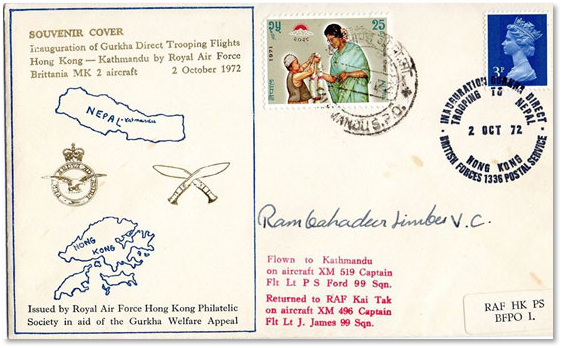
New members who have joined us recently are:

RAF
Kirk Laird, Swindon, Wilts, UK
John McDowall, Nanning, China
David Brown, Elgin Moray, UK
Daniel Fraser, Liverpool, UK
Steve Burnett, Oxford, Oxon, UK
Jason Murphy, Pershore, Worcs, UK
Terry Christie, Doncaster, UK
Mick Sullivan, Carterton, Oxon, UK
Brett May, Yate, Bristol, Glos, UK
Craig Johns, Bangkok, Thailand
Carl Chapman, Southampton, Hants, UK
Martin Cooper, Manchester, UK
Jon Morris, Newcastle, UK
Jon Harris, Lyneham, Wilts, UK

RAAF
Vince Di-Iulio, Edgewater, WA, Australia
Dudley Olsen, Coloundra, QLD, Australia
Grant Broadfield, Sydney, NSW, Australia
Ken Auckett, Sunbury, VIC, Australia
Mick Smitherman, Lobethal, SA, Australia
Michael (Mick) Hughes, Ipswich, QLD, Australia
Stuart Leslie, Amberley, QLD, Australia

RCAF
Jordie Larson, Trenton, ON, Canada
Welcome to the OBA!
RAF Cosford to welcome historic VC10
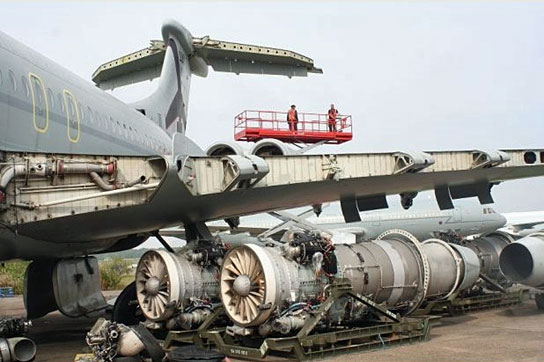
From: David Powell, Princes Risborough
Sent: Monday, May 11, 2015 6:57 PM
Subject: Re: UKMAMS OBA OBB #042515
Dear Tony
As usual the latest brief stirred a few grey memory cells. First, a bit more background to Bryan Morgan’s epic blue light ride to Heathrow. At the time I was in the fuels shop in MoD Main Building sharing an office with Arthur Roland, I was the provisioner working with the oil companies and Arthur ran the largely NATO related fuel planning team. In other words I had the ‘Rollo Freelunch’ desk and he was ‘Bottle and 200’. Prior to the dispatch of Bryan’s recce team to Ethiopia, for some weeks I been working with Shell International. The big problem was the lack of a firm decision on the mounting base - Djibouti (where the Russians wanted us out of the way) or Addis where RAF ops wanted to be? We literally had a tanker with our aviation fuel driving up and down the Red Sea while the politicking went on. On the day of the MoD briefings, there was a taxi rank of specialists. I covered the fuels bit. Along came the ‘suit’ from ‘intelligence’, who basically said ‘haven’t a clue as we only cover Warsaw Pact countries’. However, through Shell, I had been getting quite a lot of very useful telexs from their man in Addis - so basically I winged an impromptu intelligence brief from my fuels file!
And so the afternoon droned on. I knew that Bryan and the recce team were due away from Heathrow on a BA flight to Zurich at 6.15, and the clock was ticking. Once a mover always a mover, so when it got past 4 o’clock, I slipped out back to my office on the 4th floor and rang the duty commander at Scotland Yard, as you do, explained the situation and asked if we could have a police escort for the team’s staff car. Their solution was that the Met would run them to the airport. I also contacted BA at Heathrow to advise there would be a small group of ‘walk on passengers’ and the background. It was well after 5pm before the briefings finally finished. I told Bryan that his police taxi was waiting at the South Door and to leave the staff car keys and we would sort it out. Exit Bryan and co. I went back to my office where I spent an agonising 20 minutes trying to get hold of the duty BA ramp tramp to let him know what was happening, that the team were on their way but it might be a bit tight on meeting the doors time. When I finally did get hold of the guy at about 10 to six, I was greeted with ‘It’s OK they're just coming through now!’ Bryan was not shooting a line about the 18 minute ride!
Next John Holloway’s Globemaster reminded me of a 1960s FEAF story of a USAF Globemaster loadmaster shooting the line about the capability of his ‘giant transporter’, and the response of an unimpressed RAF mover pointing to a Beverly parked nearby. “Oh really - you should have seen the RAF aircraft that brought that one in!’
Finally, Tod Geoghegan watching the departing transatlantic air race Harrier. Positioning the air race kit in New York in 1969 was my swan song task with F Team, and I had the pleasure and privilege of standing with a group of hardened, mostly ex ‘Nam’, jocks as they watched in total awe and amazement the arrival of the first positioning West to East Harrier, and the usual skid to halt thirty feet up, turn to the crowd, bow and land.
Keep the faith, stay safe.
David Powell
F Team UKMAMS 1967-69
Sent: Monday, May 11, 2015 6:57 PM
Subject: Re: UKMAMS OBA OBB #042515
Dear Tony
As usual the latest brief stirred a few grey memory cells. First, a bit more background to Bryan Morgan’s epic blue light ride to Heathrow. At the time I was in the fuels shop in MoD Main Building sharing an office with Arthur Roland, I was the provisioner working with the oil companies and Arthur ran the largely NATO related fuel planning team. In other words I had the ‘Rollo Freelunch’ desk and he was ‘Bottle and 200’. Prior to the dispatch of Bryan’s recce team to Ethiopia, for some weeks I been working with Shell International. The big problem was the lack of a firm decision on the mounting base - Djibouti (where the Russians wanted us out of the way) or Addis where RAF ops wanted to be? We literally had a tanker with our aviation fuel driving up and down the Red Sea while the politicking went on. On the day of the MoD briefings, there was a taxi rank of specialists. I covered the fuels bit. Along came the ‘suit’ from ‘intelligence’, who basically said ‘haven’t a clue as we only cover Warsaw Pact countries’. However, through Shell, I had been getting quite a lot of very useful telexs from their man in Addis - so basically I winged an impromptu intelligence brief from my fuels file!
And so the afternoon droned on. I knew that Bryan and the recce team were due away from Heathrow on a BA flight to Zurich at 6.15, and the clock was ticking. Once a mover always a mover, so when it got past 4 o’clock, I slipped out back to my office on the 4th floor and rang the duty commander at Scotland Yard, as you do, explained the situation and asked if we could have a police escort for the team’s staff car. Their solution was that the Met would run them to the airport. I also contacted BA at Heathrow to advise there would be a small group of ‘walk on passengers’ and the background. It was well after 5pm before the briefings finally finished. I told Bryan that his police taxi was waiting at the South Door and to leave the staff car keys and we would sort it out. Exit Bryan and co. I went back to my office where I spent an agonising 20 minutes trying to get hold of the duty BA ramp tramp to let him know what was happening, that the team were on their way but it might be a bit tight on meeting the doors time. When I finally did get hold of the guy at about 10 to six, I was greeted with ‘It’s OK they're just coming through now!’ Bryan was not shooting a line about the 18 minute ride!
Next John Holloway’s Globemaster reminded me of a 1960s FEAF story of a USAF Globemaster loadmaster shooting the line about the capability of his ‘giant transporter’, and the response of an unimpressed RAF mover pointing to a Beverly parked nearby. “Oh really - you should have seen the RAF aircraft that brought that one in!’
Finally, Tod Geoghegan watching the departing transatlantic air race Harrier. Positioning the air race kit in New York in 1969 was my swan song task with F Team, and I had the pleasure and privilege of standing with a group of hardened, mostly ex ‘Nam’, jocks as they watched in total awe and amazement the arrival of the first positioning West to East Harrier, and the usual skid to halt thirty feet up, turn to the crowd, bow and land.
Keep the faith, stay safe.
David Powell
F Team UKMAMS 1967-69
Ambulance fits into plane for Ebola trial
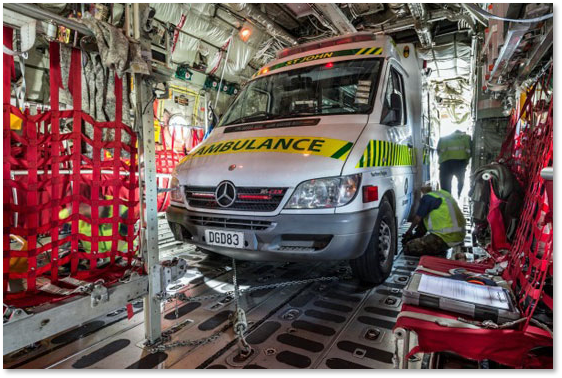
It's not everyday you see an ambulance parked in a plane. The Royal New Zealand Air Force carried out a trial loading of a St John ambulance into a C-130 Hercules at the Whenuapai Air Base on May 6. The endeavour was part of the Defence Force's support to the Government Ebola response, which is led by the Ministry of Health and a team effort with St John.
While the Hercules regularly carries military vehicles and heavy loads, this was the first time an ambulance had been loaded and secured into the plane.
Head of Aviation Medicine Squadron Leader Andy Campbell says the trial, which has been in the planning since last year, confirmed the Air Force can carry an ambulance without presenting any danger to the aircraft. "The point of the trial is looking at how we would support the Ministry of Health if they need to move a potential Ebola patient. One of the most important aspects tested was the ability to secure the ambulance to the Hercules to the standards required for it to withstand any turbulence or rapid changes in altitude in flight," he says.
While the Hercules regularly carries military vehicles and heavy loads, this was the first time an ambulance had been loaded and secured into the plane.
Head of Aviation Medicine Squadron Leader Andy Campbell says the trial, which has been in the planning since last year, confirmed the Air Force can carry an ambulance without presenting any danger to the aircraft. "The point of the trial is looking at how we would support the Ministry of Health if they need to move a potential Ebola patient. One of the most important aspects tested was the ability to secure the ambulance to the Hercules to the standards required for it to withstand any turbulence or rapid changes in altitude in flight," he says.
Several aspects had to be taken into account including the fuel load, weight distribution and number of patients the ambulance could hold.
The ambulance was also carrying an isolation pod, a clear plastic container that could be used to hold a potential patient and and allow them to be treated safely.
The Ministry of Health states the risk of Ebola in New Zealand to be very low.
Stuff.co.nz
The ambulance was also carrying an isolation pod, a clear plastic container that could be used to hold a potential patient and and allow them to be treated safely.
The Ministry of Health states the risk of Ebola in New Zealand to be very low.
Stuff.co.nz
From: John Holloway, Shrewsbury
Sent: Wednesday, May 13, 2015 4:39 AM
Subject: NS RAF Cosford Branch
Hi Tony
Our monthly meeting at Cosford went well. Our speaker on this occasion was Barry Hope and it was the third talk he had given us. He always comes dressed to go with the subject of his talk, and this time he was dressed as a G/Capt in working blue.
He spoke about Knights of the Air and the pageantry of the RFC and the RAF. He explained during his illustrated talk how the insignia of the modern-day Air Force could be traced back to the heraldic designs used in the Middle Ages by organisations such as the Knights Templar. He also explained the significance of the colours used in the various gallantry and campaign medals.
Sent: Wednesday, May 13, 2015 4:39 AM
Subject: NS RAF Cosford Branch
Hi Tony
Our monthly meeting at Cosford went well. Our speaker on this occasion was Barry Hope and it was the third talk he had given us. He always comes dressed to go with the subject of his talk, and this time he was dressed as a G/Capt in working blue.
He spoke about Knights of the Air and the pageantry of the RFC and the RAF. He explained during his illustrated talk how the insignia of the modern-day Air Force could be traced back to the heraldic designs used in the Middle Ages by organisations such as the Knights Templar. He also explained the significance of the colours used in the various gallantry and campaign medals.

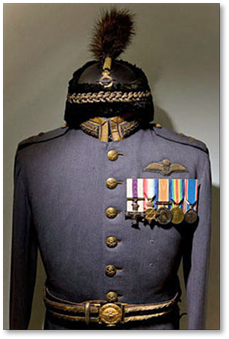
One of the interesting facts that he gave related to the colour of the Royal Air Force uniform. It appears that when the uniform colour was being considered prior to the formation of the RAF in 1918, a mill in the north country had produced a large quantity of blue-grey cloth for the Imperial Russian Cossack regiments. When the Russian Revolution took place in 1917 the order was not required and so the Air Ministry purchased the material for their new uniforms at a knock down price and hence thats how we got our blue uniform.
He told us that there is now a National Service Medal available for all who served between 1938 and 1960 when National Service/Conscription came to an end but you have to pay for them;a couple of lads said they'd got them but had to pay £35 for them; when I think of all the places I served in the Middle East and didn't get a medal, excuse the langauge but I'm buggered if I'm going to pay for a bit of metal hanging from a multi coloured ribbon!
Hope the foregoing is of interest.
Cheers
John
He told us that there is now a National Service Medal available for all who served between 1938 and 1960 when National Service/Conscription came to an end but you have to pay for them;a couple of lads said they'd got them but had to pay £35 for them; when I think of all the places I served in the Middle East and didn't get a medal, excuse the langauge but I'm buggered if I'm going to pay for a bit of metal hanging from a multi coloured ribbon!
Hope the foregoing is of interest.
Cheers
John
RCAF - Jim White Memorial Golf Tournament

The tournament this year is on the 13th of June 2015 and is again at Salt Creek Golf Links near Warkworth Ontario.
It is open to all past and present TFC Techs and their families, friends and relatives of the White family and Colborne legion members.
Cost per person is $50.00 which includes 18 holes of 4 ball best-ball with cart. After game Hamburgers and Bratwursts, Prizes and raffles.
Registration is at 11:00 opening ceremonies at 12 and shotgun start at 12:30.
Prepayment is preferred to pay for everything and avoid a traffic jam and speed up registration. Fees can be sent to me, Keith Telfer 260 Drewery St Brighton ON KOK 1HO. To get your name or team on the list call 613 475 3054 or email telferk@sympatico.ca
The last 2 have been a great success and a lot of fun so come out and enjoy a round.
It is open to all past and present TFC Techs and their families, friends and relatives of the White family and Colborne legion members.
Cost per person is $50.00 which includes 18 holes of 4 ball best-ball with cart. After game Hamburgers and Bratwursts, Prizes and raffles.
Registration is at 11:00 opening ceremonies at 12 and shotgun start at 12:30.
Prepayment is preferred to pay for everything and avoid a traffic jam and speed up registration. Fees can be sent to me, Keith Telfer 260 Drewery St Brighton ON KOK 1HO. To get your name or team on the list call 613 475 3054 or email telferk@sympatico.ca
The last 2 have been a great success and a lot of fun so come out and enjoy a round.
From: Richard Lloyd, Dalgety Bay, Fife
Sent: Friday, May 15, 2015 11:02 AM
Subject: Pressed into Service
Here's one for you, Tony!
Sent: Friday, May 15, 2015 11:02 AM
Subject: Pressed into Service
Here's one for you, Tony!
In 1968 I was a Flying Officer DAMO at RAF Northolt. My Station Commander, Gp Capt Peter Hill decided I'd be the right person to be Press Liaison Officer, given the news that significant scenes for the film 'Battle of Britain' were to filmed on the base. Maybe I was chosen because, as Mover at Northolt, we were dealing daily with VIPs and show-business people, so handling a few more wasn't going to be a problem.
But the cast was truly stellar - Michael, Caine, Lawrence Olivier, Kenneth More, Christopher Plummer, Trevor Howard, Suzannah York among others. I'd be mixing with the stars; maybe I'd so impress them etc etc. At the worst, I'd have stories to dine out for years to come 'Ah yes, I don't know if I ever told you about the time Michael Caine and I had a few beers together'.....
But the cast was truly stellar - Michael, Caine, Lawrence Olivier, Kenneth More, Christopher Plummer, Trevor Howard, Suzannah York among others. I'd be mixing with the stars; maybe I'd so impress them etc etc. At the worst, I'd have stories to dine out for years to come 'Ah yes, I don't know if I ever told you about the time Michael Caine and I had a few beers together'.....
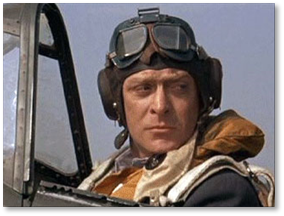
The reality was somewhat different. For a while a few plastic Hurricanes graced the hard standing outside 207 Sqn's hangar. I believe Kenneth More visited. I never saw him. I did, however see Trevor Howard getting into his car at the Mess one day. My sole contribution was to be part-time 'gopher' for Gp Capt 'Hamish' Mahaddie RAF Ret'd, the RAF and aviation consultant on the film. Mind you, he had an ego bigger than some of the stars, so I suppose that counted for something!
Richard
Richard
M1A1 Abrams on RAAF Globemaster
For the first time, an Army M1A1 Abrams tank has been flown on board a Royal Australian Air Force (RAAF) C-17A Globemaster III transport. On May the 11th, the C-17A carried the Abrams from RAAF Base Darwin to the Capricornia region as part of Exercise Hamel, where it will participate with other Defence units in the Shoalwater Bay Field Training Area. The Abrams is carefully driven up the cargo ramp of the C-17A and restrained to the cargo floor in a precise position, allowing the aircraft to remain balanced in flight. The flight of the Abrams provides vital experience for Army and Air Force personnel, emphasises a key joint strategic capability for Defence.
From: Paddy Gallaugher, London
Sent: Friday, May 15, 2015 11:10 AM
Subject: A Day (or two) to Remember
It was in the days when men were men: Movers were treated with some reserve and Condec transfer loaders hadn’t been invented.
My role as a Movements Officer on Gan was to wave at shiny VC10s and restrain anyone found trying to subvert transiting female passengers . It was a thankless task and probably accounts for my rather unflattering reputation as a “killjoy”.
One of the main problems for me was that the chief exponent of the art of spying on unsuspecting females was none other than my own shift Corporal! He could regularly be found positioned under the passenger boarding steps - apparently a strategic vantage point for connoisseurs - when he should have been scrambling around the front cargo belly to off-load the Island’s mail.
Well that very NCO was to get his own back on “Killjoy” in no uncertain terms.
Every forth month, the Movements team would be required to offload the cargo ship that entered the Lagoon with much needed beer, construction materials and other essentials not deemed suitable for air transport. It was typical of my bad luck that the month my shift was assigned the task the shipping company decided to have a discharge efficiency assessment. A group of clipboard-wielding “experts” were to fly in and observe our cargo handling prowess. Now, remember, this was the Far East and temperatures in the ship’s holds often exceeded 100 degrees. Further. the Master and crew of Cunard Brocklebank’s aging fleet of “Tramp Steamers” actually looked forward to calling into Gan - it was the one place where there were no mooring charges and hence no urgency on their part to offload freight.
“Paddy, don’t mess around with this one - MOD have assured the contractor offload will be be completed in 5 days!”
“Don’t worry Boss, you’ve picked the right man for the job this time!” I replied confidently.
Well, It was to be 10 days later that I finally left the ship. This was not good for my career profile. I quickly began to rationalise the situation. I mean, what did these so called experts know about the primitive handling conditions. And what about the local workforce ? ! Weak at the best of times, in Ramadan they ate nothing so their output was little better than a bunch of schoolgirls ! But that wasn’t the real problem. You see, it was that same mischievous NCO : it was surely he who had connived with the ship’s crew to arrange an invitation to the Captain’s table to experience some infamous seafarers’ hospitality.
And so it was that I sheepishly entered SAMO’s office to explain the terrible effects of seasickness and could I please be excused Surface Movements duties in future!
To this day, I cannot account for that 48 hours. Neither can I recall what happened to that unnamed Corporal - but if he reads this, could I please have my hat back!
Sent: Friday, May 15, 2015 11:10 AM
Subject: A Day (or two) to Remember
It was in the days when men were men: Movers were treated with some reserve and Condec transfer loaders hadn’t been invented.
My role as a Movements Officer on Gan was to wave at shiny VC10s and restrain anyone found trying to subvert transiting female passengers . It was a thankless task and probably accounts for my rather unflattering reputation as a “killjoy”.
One of the main problems for me was that the chief exponent of the art of spying on unsuspecting females was none other than my own shift Corporal! He could regularly be found positioned under the passenger boarding steps - apparently a strategic vantage point for connoisseurs - when he should have been scrambling around the front cargo belly to off-load the Island’s mail.
Well that very NCO was to get his own back on “Killjoy” in no uncertain terms.
Every forth month, the Movements team would be required to offload the cargo ship that entered the Lagoon with much needed beer, construction materials and other essentials not deemed suitable for air transport. It was typical of my bad luck that the month my shift was assigned the task the shipping company decided to have a discharge efficiency assessment. A group of clipboard-wielding “experts” were to fly in and observe our cargo handling prowess. Now, remember, this was the Far East and temperatures in the ship’s holds often exceeded 100 degrees. Further. the Master and crew of Cunard Brocklebank’s aging fleet of “Tramp Steamers” actually looked forward to calling into Gan - it was the one place where there were no mooring charges and hence no urgency on their part to offload freight.
“Paddy, don’t mess around with this one - MOD have assured the contractor offload will be be completed in 5 days!”
“Don’t worry Boss, you’ve picked the right man for the job this time!” I replied confidently.
Well, It was to be 10 days later that I finally left the ship. This was not good for my career profile. I quickly began to rationalise the situation. I mean, what did these so called experts know about the primitive handling conditions. And what about the local workforce ? ! Weak at the best of times, in Ramadan they ate nothing so their output was little better than a bunch of schoolgirls ! But that wasn’t the real problem. You see, it was that same mischievous NCO : it was surely he who had connived with the ship’s crew to arrange an invitation to the Captain’s table to experience some infamous seafarers’ hospitality.
And so it was that I sheepishly entered SAMO’s office to explain the terrible effects of seasickness and could I please be excused Surface Movements duties in future!
To this day, I cannot account for that 48 hours. Neither can I recall what happened to that unnamed Corporal - but if he reads this, could I please have my hat back!
Hercules' flying life to be extended - Brownlee
The flying life of the RNZAF's fleet of C130 Hercules planes is expected to be extended until 2022, Defence Minister Gerry Brownlee has revealed.
The aircraft, which are known as the Air Force's work horses, mark five decades of service this year.
Over the last 10 years the Government has spent more than $250 million upgrading the planes with the aim of extending their flying life until 2020.
But Defence Minister Gerry Brownlee says the Hercules upgrade has brought them an extra couple of years.
"Although they are fifty, they have been substantially refurbished, arguably fly better than they have ever done and can run through to about 2022".
Used extensively in the Pacific for humanitarian reasons and for the transportation of manpower and aid in times of disaster, the Hercules are invaluable for landing on the Pacific's runways, which are often short and in poor condition.
Mr Brownlee says any replacement would need to be able to "have similar utility".
The Government is currently pricing out the C-17 Globemaster, which is worth hundreds of millions of dollars.
Other options include the A400 military transporter although appetite for this is likely to have waned following a test flight crash in Spain yesterday that prompted Britain and Germany to ground their A400 troop and cargo carriers.
But whatever the replacements are it won't be cheap and the budget is being kept under wraps.
"It would have been a very expensive exercise back in 1965 when the commitment to the Hercules was made but we got fifty years out of them and any procurement has to be seen in that sort of light," says Mr Brownlee.
" I wouldn't like to speculate on the price at the moment, I think when you are in commercial negotiations the last thing you should do is open your wallet to show how much is in it".
TVNZ One News
The aircraft, which are known as the Air Force's work horses, mark five decades of service this year.
Over the last 10 years the Government has spent more than $250 million upgrading the planes with the aim of extending their flying life until 2020.
But Defence Minister Gerry Brownlee says the Hercules upgrade has brought them an extra couple of years.
"Although they are fifty, they have been substantially refurbished, arguably fly better than they have ever done and can run through to about 2022".
Used extensively in the Pacific for humanitarian reasons and for the transportation of manpower and aid in times of disaster, the Hercules are invaluable for landing on the Pacific's runways, which are often short and in poor condition.
Mr Brownlee says any replacement would need to be able to "have similar utility".
The Government is currently pricing out the C-17 Globemaster, which is worth hundreds of millions of dollars.
Other options include the A400 military transporter although appetite for this is likely to have waned following a test flight crash in Spain yesterday that prompted Britain and Germany to ground their A400 troop and cargo carriers.
But whatever the replacements are it won't be cheap and the budget is being kept under wraps.
"It would have been a very expensive exercise back in 1965 when the commitment to the Hercules was made but we got fifty years out of them and any procurement has to be seen in that sort of light," says Mr Brownlee.
" I wouldn't like to speculate on the price at the moment, I think when you are in commercial negotiations the last thing you should do is open your wallet to show how much is in it".
TVNZ One News
From: Frank Lightfoot, Glasgow
Sent: Friday, May 15, 2015 3:11 PM
Subject: Re: The next OBA Newsletter - Pressed Into Service
Hi Tony,
The old grey matter is fading but I have memories of doubling as an infill AQM due to a flue outbreak in 52 Sqn. Two Andovers were scheduled for the NATO bigwigs conducting the SEATO tour it was a low level and a few used the Bags provided. I think Chas Cormack was on the other aircraft, I’m sure he can fill in the details
The other oddball was instructing 55ADR newbies on the complexities of the Trianco Transfer Loader (that was a proper Chinese puzzle).
I have noticed that the taskings performed 1967-69 by FEAF MAMS, are short of any published detail. My old diaries have have been destroyed due to house moves, loft storage and the children in the process of growing up. Pictures and slides are also casualties. My daughter and grandson found a crumpled old album with some faded shots at Kathmandu. I’ve got one of Chas strolling down the street followed by the sacred cows and one of Len B striding out under a Hercs wing wearing his MAMS Hat, scarf and 6 Gun (Leong Nok Tha). I think that was his last stint before Vick King replaced him.
Just wondering if Colin Heitus/ George Hyslop / Derek Graham/James Ian Barr/ and A n other have made contact.
In 1970 I was sent to Machrihanish POL for a NATO exercise. Chris Seirwald, a pilot of 52 Sqn found out I was there
and I was seconded to 52 sqdn for the excercise duration . It was great to be back in Andovers terrain flying like 633 Sqn only slower - low level MSP drops
Daughter dear and Grandson are here at the moment pulling the place apart looking for Photos of Pa Pa's past to find out how MAMS could be in the RAF. Will be back when they find what they are looking for.
Again Tony you have my sincere thanks for holding OBA together
I wonder if anyone remembers the times at our Bungalow in 14 Leith Road Serangoon? UKMAMS paid us visits on the way out and on their way back
Frank
ex A Team FEAF MAMS
Sent: Friday, May 15, 2015 3:11 PM
Subject: Re: The next OBA Newsletter - Pressed Into Service
Hi Tony,
The old grey matter is fading but I have memories of doubling as an infill AQM due to a flue outbreak in 52 Sqn. Two Andovers were scheduled for the NATO bigwigs conducting the SEATO tour it was a low level and a few used the Bags provided. I think Chas Cormack was on the other aircraft, I’m sure he can fill in the details
The other oddball was instructing 55ADR newbies on the complexities of the Trianco Transfer Loader (that was a proper Chinese puzzle).
I have noticed that the taskings performed 1967-69 by FEAF MAMS, are short of any published detail. My old diaries have have been destroyed due to house moves, loft storage and the children in the process of growing up. Pictures and slides are also casualties. My daughter and grandson found a crumpled old album with some faded shots at Kathmandu. I’ve got one of Chas strolling down the street followed by the sacred cows and one of Len B striding out under a Hercs wing wearing his MAMS Hat, scarf and 6 Gun (Leong Nok Tha). I think that was his last stint before Vick King replaced him.
Just wondering if Colin Heitus/ George Hyslop / Derek Graham/James Ian Barr/ and A n other have made contact.
In 1970 I was sent to Machrihanish POL for a NATO exercise. Chris Seirwald, a pilot of 52 Sqn found out I was there
and I was seconded to 52 sqdn for the excercise duration . It was great to be back in Andovers terrain flying like 633 Sqn only slower - low level MSP drops
Daughter dear and Grandson are here at the moment pulling the place apart looking for Photos of Pa Pa's past to find out how MAMS could be in the RAF. Will be back when they find what they are looking for.
Again Tony you have my sincere thanks for holding OBA together
I wonder if anyone remembers the times at our Bungalow in 14 Leith Road Serangoon? UKMAMS paid us visits on the way out and on their way back
Frank
ex A Team FEAF MAMS
From: Charles Cormack, Lyneham Village
Sent: Sunday, May 17, 2015 10:36 AM
Subject: Re: The next OBA Newsletter - Pressed Into Service
I can recall a trip to all the American bases in Thailand (Ubon Korat Udon) which was the RCDS tour and they ended up using 2 Andovers as the VIP aircraft which was based at Don Muang, Bangkok was u/s, and although I can’t remember doing it perhaps Len Bowen might.
On a similar tack I do remember doing a trip with 70sqn from Nicosia to Adana to pick up a ground crew guy from 543 Sqn who had been hit over the head by a starting handle (if you can remember them) by a Turkish taxi driver and flying him to Akrotiri hospital as there was not an AQM (if you remember them, mostly supply sergeants) available at short notice
Hope this helps.
Chas
Sent: Sunday, May 17, 2015 10:36 AM
Subject: Re: The next OBA Newsletter - Pressed Into Service
I can recall a trip to all the American bases in Thailand (Ubon Korat Udon) which was the RCDS tour and they ended up using 2 Andovers as the VIP aircraft which was based at Don Muang, Bangkok was u/s, and although I can’t remember doing it perhaps Len Bowen might.
On a similar tack I do remember doing a trip with 70sqn from Nicosia to Adana to pick up a ground crew guy from 543 Sqn who had been hit over the head by a starting handle (if you can remember them) by a Turkish taxi driver and flying him to Akrotiri hospital as there was not an AQM (if you remember them, mostly supply sergeants) available at short notice
Hope this helps.
Chas
From: Len Bowen, Chisholm ACT
Sent: Monday, May 18, 2015 3:18 AM
Subject: Re: The next OBA Newsletter - Pressed Into Service
G’day Tony.
No personal gen on the SEATO Tour in question. At that time (1967 - 1969) we still had three teams on FEAF MAMS, and it must have been one of the other lot that got lucky (?) on this one.
Yrs Aye
Len
Sent: Monday, May 18, 2015 3:18 AM
Subject: Re: The next OBA Newsletter - Pressed Into Service
G’day Tony.
No personal gen on the SEATO Tour in question. At that time (1967 - 1969) we still had three teams on FEAF MAMS, and it must have been one of the other lot that got lucky (?) on this one.
Yrs Aye
Len
Gibraltar Rock Flown to UK for Memorial Project
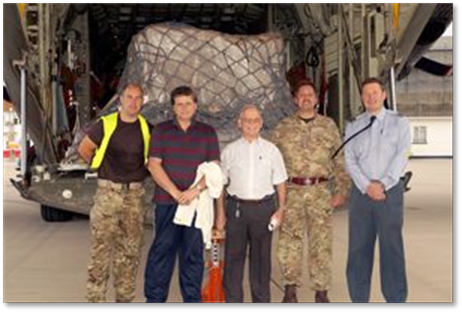
Phase I of the Gibraltar War Memorial to be erected in UK was completed on Sunday evening when a C130 Hercules transport aircraft of the RAF executed the airlift to RAF Brize Norton.
The lump of Gibraltar limestone rock, originally a 10-tonne solid piece, was first reduced to 4.6 tonnes in March when the UK stone masons came out to inspect it.
However they returned in April to further reduce it to ‘airlift pallet weight requirements’; the final 2.8 tonne piece will be carved into a model replica of the Rock of Gibraltar and mounted on an altar of remembrance dedicated to those Gibraltarians who served in HM Armed Forces and died in action during WWI & WWII. The monument, funded by the Government of Gibraltar, will sit in a prime location at the UK National Memorial Arboretum, in Lichfield, Staffordshire and will be unveiled later this year.
The lump of Gibraltar limestone rock, originally a 10-tonne solid piece, was first reduced to 4.6 tonnes in March when the UK stone masons came out to inspect it.
However they returned in April to further reduce it to ‘airlift pallet weight requirements’; the final 2.8 tonne piece will be carved into a model replica of the Rock of Gibraltar and mounted on an altar of remembrance dedicated to those Gibraltarians who served in HM Armed Forces and died in action during WWI & WWII. The monument, funded by the Government of Gibraltar, will sit in a prime location at the UK National Memorial Arboretum, in Lichfield, Staffordshire and will be unveiled later this year.
Attending at the loading of the ‘Rock’ were Deputy Chief of Staff Colonel Frank Green (late of RE), Wing Commander Gregory Smith RAF Gib, and Corporal Mark Benstead.
Present at the airlift were the architect of this project, Joe Brugada, and his colleague, creative designer Anselmo Torres.
Mr Brugada expressed his ‘immense appreciation’ for help and support he had received from the Governor Sir James Dutton, Commander British Forces Commodore Ian McGhie, and especially Wing Commander Smith, WO Phill Armitage.
Corporal Mar (Benny) Benstead has also provided invaluable help in taking Phase I to fruition.
Gibraltar Chronicle
Present at the airlift were the architect of this project, Joe Brugada, and his colleague, creative designer Anselmo Torres.
Mr Brugada expressed his ‘immense appreciation’ for help and support he had received from the Governor Sir James Dutton, Commander British Forces Commodore Ian McGhie, and especially Wing Commander Smith, WO Phill Armitage.
Corporal Mar (Benny) Benstead has also provided invaluable help in taking Phase I to fruition.
Gibraltar Chronicle
From: Steve Perry, Royal Wootton Bassett
Sent: Friday, May 15, 2015 4:08 PM
Subject: Re: UKMAMS OBA OBB #042515
Hi Tony
It was interesting reading Bryan Morgan's letter regarding Op Bushel. I, along with quite a few others arrived in Addis Ababa on November 2nd, at the very start of the operation.
Our early trips into Asseb were a bit chaotic as there was no one there to direct the trucks to the correct aircraft and time was lost chasing them about.
On the 6th November it was decided to leave a couple of us at Asseb to sort out loads when "Albert" arrived. Myself, Pete Mahon and an army signaller were volunteered for the task. Dave Spencer might have been with us but can't be certain. Once the aircraft had departed there wasn't much to do so we parked ourselves on some bags of grain and watched the world go by.
Out of the blue a Russian aircraft landed, this was the first we had seen of them. A couple of officers came over to us, one being a very senior officer in full dress uniform complete with oversized hat and more medals than Audie Murphy, Patton and Rambo put together. Through an interpreter he informed us "that for the good of the people of Ethiopia on this occasion we will work together"
Good old Pete drew himself up to his full height of 5' 6" and answered in his broadest Irish accent, "On behalf of Her Majesty's government I agree". We shook hands and off they went.
Sent: Friday, May 15, 2015 4:08 PM
Subject: Re: UKMAMS OBA OBB #042515
Hi Tony
It was interesting reading Bryan Morgan's letter regarding Op Bushel. I, along with quite a few others arrived in Addis Ababa on November 2nd, at the very start of the operation.
Our early trips into Asseb were a bit chaotic as there was no one there to direct the trucks to the correct aircraft and time was lost chasing them about.
On the 6th November it was decided to leave a couple of us at Asseb to sort out loads when "Albert" arrived. Myself, Pete Mahon and an army signaller were volunteered for the task. Dave Spencer might have been with us but can't be certain. Once the aircraft had departed there wasn't much to do so we parked ourselves on some bags of grain and watched the world go by.
Out of the blue a Russian aircraft landed, this was the first we had seen of them. A couple of officers came over to us, one being a very senior officer in full dress uniform complete with oversized hat and more medals than Audie Murphy, Patton and Rambo put together. Through an interpreter he informed us "that for the good of the people of Ethiopia on this occasion we will work together"
Good old Pete drew himself up to his full height of 5' 6" and answered in his broadest Irish accent, "On behalf of Her Majesty's government I agree". We shook hands and off they went.
It was interesting over the next few weeks to arrive at places like Mekele and Gondar delivering grain to find the Russians there delivering armaments! I have some sneakily taken photos which I will try and find.
I don't recall much other contact with the Russians other than seeing their aicraft arriving at Addis crammed full of refugees they were resettling.
We did have a much closer relationship with the Polish Air Force who provided Mil 8 (Hip) helicopters to support the air drop operations. Ironically the first helicopter I ever flew on was a Russian one into the depths of Ethiopia, trying to keep the locals out of the drop zone. No doubt some will remember the Germans dropping a pallet of aid on some poor Ethiopians hut! Old habits die hard I suppose.
The Poles turned up at most of our social events and were very generous with their Vodka!
The Operation lasted far longer than 2 months. I did a second tour in March 1985 until the middle of April and it went on for quite a while after that.
It was certainly one of the highlights of my RAF career, and I will never forget Pete's response to the Russian General. Absolute class!
Best wishes
Steve Perry
I don't recall much other contact with the Russians other than seeing their aicraft arriving at Addis crammed full of refugees they were resettling.
We did have a much closer relationship with the Polish Air Force who provided Mil 8 (Hip) helicopters to support the air drop operations. Ironically the first helicopter I ever flew on was a Russian one into the depths of Ethiopia, trying to keep the locals out of the drop zone. No doubt some will remember the Germans dropping a pallet of aid on some poor Ethiopians hut! Old habits die hard I suppose.
The Poles turned up at most of our social events and were very generous with their Vodka!
The Operation lasted far longer than 2 months. I did a second tour in March 1985 until the middle of April and it went on for quite a while after that.
It was certainly one of the highlights of my RAF career, and I will never forget Pete's response to the Russian General. Absolute class!
Best wishes
Steve Perry
Ukraine unveils transport plane able to operate on unpaved runways
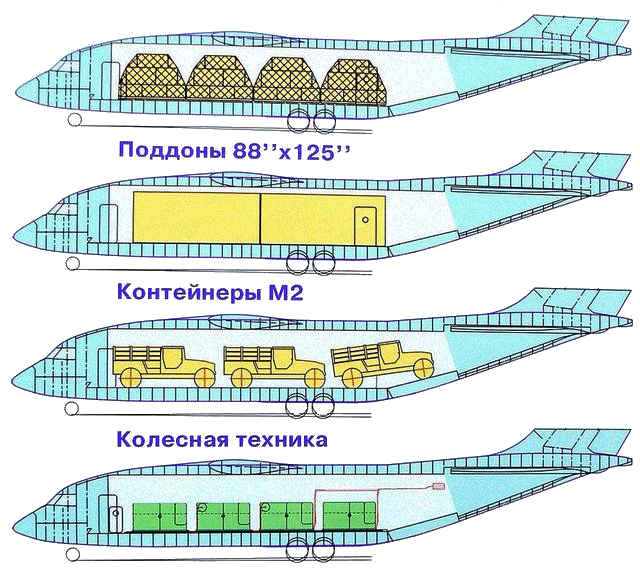
Ukrainian state-run aircraft manufacturer Antonov on Thursday unveiled its new medium-sized transport aircraft An-178, which is able to take off and land on unpaved runways.
The aircraft, which has a payload capacity of up to 18 tonnes with a maximum speed of 800 km per hour, was displayed to public during a ceremony in Kiev.
The plane is equipped with two turbofan engines located high on fuselage and protected against dust and soil, which allows the aircraft to operate on unprepared surfaces, the company said in a statement.
The aircraft was designed mainly for transporting cargoes, such as self-propelled machinery and large shipping containers, but it could also be used in commercial and military aviation, according to Dmytro Kiva, the chief designer at Antonov Company.
The An-178 will go through a ground test in the coming days and it will make its first flight in May. The market price of the plane is expected to be around 20 million U.S. dollars to 25 million dollars per unit, according to the statement.
English.news.cn
The aircraft, which has a payload capacity of up to 18 tonnes with a maximum speed of 800 km per hour, was displayed to public during a ceremony in Kiev.
The plane is equipped with two turbofan engines located high on fuselage and protected against dust and soil, which allows the aircraft to operate on unprepared surfaces, the company said in a statement.
The aircraft was designed mainly for transporting cargoes, such as self-propelled machinery and large shipping containers, but it could also be used in commercial and military aviation, according to Dmytro Kiva, the chief designer at Antonov Company.
The An-178 will go through a ground test in the coming days and it will make its first flight in May. The market price of the plane is expected to be around 20 million U.S. dollars to 25 million dollars per unit, according to the statement.
English.news.cn
From: Gordon Black, Swindon
Sent: Sunday, May 17, 2015 9:45 AM
Subject: Re: The next OBA Newsletter - Pressed Into Service
Tony,
While stationed at RAF Gutersloh the main runway was closed for refurbishment and we were detached to GAF Wunsdorf to handle all AT movements.
We used to work there for a week and then have a week off (to recover). During one of our weeks off the SAMO volunteered us to assist the Harrier Force on their deployment to the Senelager Ranges. We had to man the Ground Defence Operation Centres for the various sites.
As you can imagine what we knew about ground defence could be written on the back of a fag packet! But off we went.
I was put in a caravan to man the radios for the various guard posts situated around the site, I remember one occasion when the guard came over the radio to inform us they were under fire, when asked are you returning fire the reply came, yes, verbally!
While the enemy had all sorts of pyros, ammo at their disposal the harrier force had nothing!! So were overrun.
We spent about 8 days in the field being no use or ornament to anyone, and assistance from the movers was never asked for again.
But it was a sight to behold seeing those aircraft appear from behind trees down dirt tracks and leap into the sky!
Gordon
Sent: Sunday, May 17, 2015 9:45 AM
Subject: Re: The next OBA Newsletter - Pressed Into Service
Tony,
While stationed at RAF Gutersloh the main runway was closed for refurbishment and we were detached to GAF Wunsdorf to handle all AT movements.
We used to work there for a week and then have a week off (to recover). During one of our weeks off the SAMO volunteered us to assist the Harrier Force on their deployment to the Senelager Ranges. We had to man the Ground Defence Operation Centres for the various sites.
As you can imagine what we knew about ground defence could be written on the back of a fag packet! But off we went.
I was put in a caravan to man the radios for the various guard posts situated around the site, I remember one occasion when the guard came over the radio to inform us they were under fire, when asked are you returning fire the reply came, yes, verbally!
While the enemy had all sorts of pyros, ammo at their disposal the harrier force had nothing!! So were overrun.
We spent about 8 days in the field being no use or ornament to anyone, and assistance from the movers was never asked for again.
But it was a sight to behold seeing those aircraft appear from behind trees down dirt tracks and leap into the sky!
Gordon
France Flying A400M in 'Essential Operations'
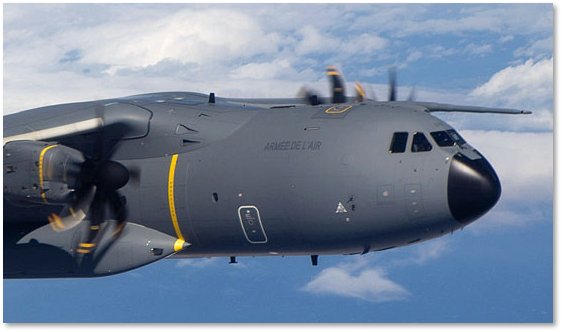
France has restricted flights following the deadly crash of the Airbus A400M in Spain, but operational needs in Africa and Iraq make the French Air Force the sole service flying the military transport plane.
On May 10, Defense Minister Jean-Yves Le Drian said the A400M would fly for "essential operations" only, pending the outcome of the Spanish inquiry into the loss the of the MSN 023 unit. Four Airbus staff were killed and two were severely injured in the crash of the aircraft, which was built for Turkey.
Much of the flying will have been for evaluation and test by the Air Force, needed to reach an initial operating capability (IOC), said an Air Force officer who declined to be identified. IOC requires a full spectrum of mission capability, and the service needs to train crews to fly a full squadron of 10 to 12 transports.
On May 10, Defense Minister Jean-Yves Le Drian said the A400M would fly for "essential operations" only, pending the outcome of the Spanish inquiry into the loss the of the MSN 023 unit. Four Airbus staff were killed and two were severely injured in the crash of the aircraft, which was built for Turkey.
Much of the flying will have been for evaluation and test by the Air Force, needed to reach an initial operating capability (IOC), said an Air Force officer who declined to be identified. IOC requires a full spectrum of mission capability, and the service needs to train crews to fly a full squadron of 10 to 12 transports.
France has six A400Ms
French special forces are keen to receive the fully tested and equipped aircraft. One of the key training aspects is for pilots to fly the transport and tanker as a fighter aircraft, including fast and low. The Air Force is also moving to train fighter pilots to fly transport aircraft.
An important French requirement is installing a radar warning receiver among the defensive aids suite offered, the officer said.
The six A400Ms are in the Touraine squadron at the Orleans air base, south of the capital. The first aircraft was delivered in 2013.
The French Air Force often flies the A400M, dubbed Atlas, to support the Barkhane and Chammal operations, the Defense Ministry said in its note on the weekly press briefing. The service flew an A400M around the world from Feb. 19 to March 6.
"There is an operational necessity," said Jean-Claude Brisset, senior fellow at think tank Institut des Relations Internationales et Stratégiques.
Some 3,000 French troops are deployed across five countries in the Barkhane operation, a fight against Islamist insurgents in sub-Saharan Africa, and 700 soldiers are active in Iraq under the Chammal operation. The fleet of Transall C-160s is worn out and each flight to resupply the overseas troops requires two or three stopovers.
"There is an absolute necessity for the A400M," Brisset said. An A400M can fly to Mali with a heavier load than a C-160 and can land in a shorter and rougher airstrip than the C-17 and C-5.
An important French requirement is installing a radar warning receiver among the defensive aids suite offered, the officer said.
The six A400Ms are in the Touraine squadron at the Orleans air base, south of the capital. The first aircraft was delivered in 2013.
The French Air Force often flies the A400M, dubbed Atlas, to support the Barkhane and Chammal operations, the Defense Ministry said in its note on the weekly press briefing. The service flew an A400M around the world from Feb. 19 to March 6.
"There is an operational necessity," said Jean-Claude Brisset, senior fellow at think tank Institut des Relations Internationales et Stratégiques.
Some 3,000 French troops are deployed across five countries in the Barkhane operation, a fight against Islamist insurgents in sub-Saharan Africa, and 700 soldiers are active in Iraq under the Chammal operation. The fleet of Transall C-160s is worn out and each flight to resupply the overseas troops requires two or three stopovers.
"There is an absolute necessity for the A400M," Brisset said. An A400M can fly to Mali with a heavier load than a C-160 and can land in a shorter and rougher airstrip than the C-17 and C-5.
The Spanish military air crash authorities have sent the two black box flight recorders to the French Bureau Enquêtes Accidents Défense Air (BEAD), the defense accident inquiry office, Reuters reported May 13. There are hopes the French technicians can deliver readings of the cockpit voice and instrument recorders in 48 hours.
Fernando Alonso, head of the A400M program, was one of the eight company staff onboard the MSN 4 on May 12, the first test flight since the crash. The company-owned prototype plane took off at 2:45 p.m. from Toulouse, southern France, and landed at 4:35 p.m. at Seville.
The flight restrictions, which exclude the company-owned aircraft, now depends on the eagerly awaited results of a Spanish accident inquiry, which may lead to guidance notes on flying the aircraft. Airbus will continue with the flight test program, needed to test more capable versions.
A restricted use of the A400M led to cancellation of a flight to carry international journalists on a planned press trip ahead of the Paris Air Show. Another operational factor, namely high operational demand for the Rafale fighter jet, led to the service canceling the media trip.
The military cockpit draws heavily on civil technology developed for the Airbus A380 superjumbo. The four high-powered turboprop TP400 engines are built by Europrop International, a consortium comprising Rolls Royce of Britain, Safran's Snecma of France, MTU of Germany and ITP of Spain.
Airbus built the MSN 023 for Turkey, with delivery due next month. Turkey has ordered 10 of the aircraft.
The aircraft builder, due to production delays, agreed to a revised delivery timetable with the eight client countries - Britain, Belgium, France, Germany, Luxembourg, Malaysia, Spain and Turkey.
Airbus Group, the parent company, announced in February a charge of €550 million (US $626 million) to cover production and delivery delays on the A400M.
Fernando Alonso, head of the A400M program, was one of the eight company staff onboard the MSN 4 on May 12, the first test flight since the crash. The company-owned prototype plane took off at 2:45 p.m. from Toulouse, southern France, and landed at 4:35 p.m. at Seville.
The flight restrictions, which exclude the company-owned aircraft, now depends on the eagerly awaited results of a Spanish accident inquiry, which may lead to guidance notes on flying the aircraft. Airbus will continue with the flight test program, needed to test more capable versions.
A restricted use of the A400M led to cancellation of a flight to carry international journalists on a planned press trip ahead of the Paris Air Show. Another operational factor, namely high operational demand for the Rafale fighter jet, led to the service canceling the media trip.
The military cockpit draws heavily on civil technology developed for the Airbus A380 superjumbo. The four high-powered turboprop TP400 engines are built by Europrop International, a consortium comprising Rolls Royce of Britain, Safran's Snecma of France, MTU of Germany and ITP of Spain.
Airbus built the MSN 023 for Turkey, with delivery due next month. Turkey has ordered 10 of the aircraft.
The aircraft builder, due to production delays, agreed to a revised delivery timetable with the eight client countries - Britain, Belgium, France, Germany, Luxembourg, Malaysia, Spain and Turkey.
Airbus Group, the parent company, announced in February a charge of €550 million (US $626 million) to cover production and delivery delays on the A400M.
Defense News
Movements Masters 5-a-Side Football Competition - 11 September 2015
AMS at RAF Brize Norton will be organising and hosting the 2015 RAF Movements Trade 6-a-side Football Competition, the Pengelly Trophy on Sat 12 Sep 15.
This year sees the Competition celebrate its 21st Anniversary, and following the success of last year’s inaugural event, we are planning to hold another Movements Masters 5-a-side competition during the evening prior to the main competition.
This year sees the Competition celebrate its 21st Anniversary, and following the success of last year’s inaugural event, we are planning to hold another Movements Masters 5-a-side competition during the evening prior to the main competition.
(Download information package)
From: David Stevens, Bangor
Sent: Tuesday, May 26, 2015 8:37 AM
Subject: 1st Battalion Coldstream Guards - 1965
Hi Tony
A bit marginal, but there was one occasion when I was singled out(from a cast of 1,000s) at the end of January 1965 and sent to BAOR Iserlohn to give some air mobility training to the 1st Battalion Coldstream Guards. I was a 23 year Flying Officer at the time and not short of experience of working with the army.
Well, it was a hoot - I was not a 'trained' trainer, I had no training notes, no hand outs, no script, but from goodness knows where the regiment had managed to acquire an aircraft fuselage mock-up and some lashing equipment. So with the help of my regimental counter-part, am awfully nice chap(!), we came up with a purely hands-on approach to preparing vehicles and heavy equipment for loading and then the lashing down. I spent the best part of 3 weeks with the regiment.
Now, here is the really interesting part. The first morning that I went down to breakfast I was somewhat taken aback to see all the officers at the table wearing their hats!! For a moment I thought maybe I should go and get my hat, but I decided this was a ruse for the unsuspecting new RAF officer in their presence, and I decided to play along with it. However, this went on for several days. No one said anything, but on day five I plucked up the courage to ask my counter-part about the wearing hats in the dining room and should I do the same? He explained, in a kindly way, that it was a battle 'dishonour' thing when at some famous battle, way back in history, the regiment was caught out unawares/unprepared and suffered a heavy defeat. The punishment was that the officers henceforth were to wear their hats at meal times as a measure of preparedness!!!
Thanks for the opportunity to share this anecdote and kind regards,
David
Sent: Tuesday, May 26, 2015 8:37 AM
Subject: 1st Battalion Coldstream Guards - 1965
Hi Tony
A bit marginal, but there was one occasion when I was singled out(from a cast of 1,000s) at the end of January 1965 and sent to BAOR Iserlohn to give some air mobility training to the 1st Battalion Coldstream Guards. I was a 23 year Flying Officer at the time and not short of experience of working with the army.
Well, it was a hoot - I was not a 'trained' trainer, I had no training notes, no hand outs, no script, but from goodness knows where the regiment had managed to acquire an aircraft fuselage mock-up and some lashing equipment. So with the help of my regimental counter-part, am awfully nice chap(!), we came up with a purely hands-on approach to preparing vehicles and heavy equipment for loading and then the lashing down. I spent the best part of 3 weeks with the regiment.
Now, here is the really interesting part. The first morning that I went down to breakfast I was somewhat taken aback to see all the officers at the table wearing their hats!! For a moment I thought maybe I should go and get my hat, but I decided this was a ruse for the unsuspecting new RAF officer in their presence, and I decided to play along with it. However, this went on for several days. No one said anything, but on day five I plucked up the courage to ask my counter-part about the wearing hats in the dining room and should I do the same? He explained, in a kindly way, that it was a battle 'dishonour' thing when at some famous battle, way back in history, the regiment was caught out unawares/unprepared and suffered a heavy defeat. The punishment was that the officers henceforth were to wear their hats at meal times as a measure of preparedness!!!
Thanks for the opportunity to share this anecdote and kind regards,
David
From: Penny Bowen, Chisholm, ACT
Sent: Tuesday, May 26, 2015 7:35 PM
Subject: Re: The next OBA Newsletter - Pressed Into Service
G’day Tony,
Pressed Into Service #1. QANTAS Cabin Attendant. January 1989. Perhaps ‘pressed’ is rather unfair, as I was a (very) willing volunteer on this chore. In late 1988 we, the whole Bowen family, went back to UK to spend Christmas with wife Penny’s family. After a wonderful few weeks in and around London and the Cotswolds we arrived at Heathrow on the early morning of our departure on 19th January 1989 to fly home - only to find the place socked in with 100% fog, which never cleared all day. After much messing around with which I will not bore your readers, in the late afternoon we were eventually moved by bus to Stanstead Airport, north of London, where our lovely QANTAS B747 awaited us.
After some further delays, which involved, amongst other things, broaching our ‘duty free’ as the Stanstead bar had closed, and introducing a number of Poms to the Aussie game of ‘two-up’ (another story for another time), we boarded the aircraft. There we were greated by an announcement from the Chief Steward: “Good evening ladies and gentlemen. We are very sorry for the delay which was outside our control, but will be on our way shortly. Unfortunatley, because of this delay, our cabin staff are out of crew duty hours. Some, however, have volunteered to stay on to at least get you as far as Bangkok. As a result, there will only a limited cabin service on this leg. If, however anyone who has any airline experience would like to help our team out we would love to hear from you once we are airborne”.
As soon as we were established in the climb and the seat belt sign was off - and after consultation with Penny, who was exhausted with having had to deal with two small but boisterous boys during the whole day’s delay off and just wanted to go to sleep - I made my way to the galley and introduced myself to the two rather frazzled stewardesses, “G’day. I’m Len Bowen. I’m in the RAAF, and I’m an Air Movements Officer. Can I help?”.
At this time we had been joined by another bloke - “G’day, I’m Fred*. I’m a Warrant Officer in the Australian Army, in the Royal Australian Corps of Transport. Can I help?”.
Senior Stewardess: “Hell yes! Do you think you blokes could manage the drinks trolley for Economy?” Silly, silly question!
Sent: Tuesday, May 26, 2015 7:35 PM
Subject: Re: The next OBA Newsletter - Pressed Into Service
G’day Tony,
Pressed Into Service #1. QANTAS Cabin Attendant. January 1989. Perhaps ‘pressed’ is rather unfair, as I was a (very) willing volunteer on this chore. In late 1988 we, the whole Bowen family, went back to UK to spend Christmas with wife Penny’s family. After a wonderful few weeks in and around London and the Cotswolds we arrived at Heathrow on the early morning of our departure on 19th January 1989 to fly home - only to find the place socked in with 100% fog, which never cleared all day. After much messing around with which I will not bore your readers, in the late afternoon we were eventually moved by bus to Stanstead Airport, north of London, where our lovely QANTAS B747 awaited us.
After some further delays, which involved, amongst other things, broaching our ‘duty free’ as the Stanstead bar had closed, and introducing a number of Poms to the Aussie game of ‘two-up’ (another story for another time), we boarded the aircraft. There we were greated by an announcement from the Chief Steward: “Good evening ladies and gentlemen. We are very sorry for the delay which was outside our control, but will be on our way shortly. Unfortunatley, because of this delay, our cabin staff are out of crew duty hours. Some, however, have volunteered to stay on to at least get you as far as Bangkok. As a result, there will only a limited cabin service on this leg. If, however anyone who has any airline experience would like to help our team out we would love to hear from you once we are airborne”.
As soon as we were established in the climb and the seat belt sign was off - and after consultation with Penny, who was exhausted with having had to deal with two small but boisterous boys during the whole day’s delay off and just wanted to go to sleep - I made my way to the galley and introduced myself to the two rather frazzled stewardesses, “G’day. I’m Len Bowen. I’m in the RAAF, and I’m an Air Movements Officer. Can I help?”.
At this time we had been joined by another bloke - “G’day, I’m Fred*. I’m a Warrant Officer in the Australian Army, in the Royal Australian Corps of Transport. Can I help?”.
Senior Stewardess: “Hell yes! Do you think you blokes could manage the drinks trolley for Economy?” Silly, silly question!
So for the next two hours until ‘lights out’, somewhere over Southern Europe, Fred and I worked the drinks trolley up and down the aisles in Economy, serving drinks as required to some very tired but, eventually, very happy passengers. It should be said, however, that early in our sojourn as cabin attendants, when we were pushing out the post-takeoff champagne, Fred & I worked on the principle of one glass for a passenger and one glass for us; one glass for a passenger and one glass for us etc etc. As a result, the path the trolley followed was somewhat erratic by the time everyone was fully sated with booze - and we’d had had to replenish the stocks several times.
I slept well for the remaining 6 ½ hours to Bangkok!
Pressed into Service #2. Livestock Agent. July 2004. After I left the Permanent RAAF in November 1999, on age retirement, I joined the RAAF Reserve, and amongst a number of other jobs over the next fourteen years I worked off and on as VIP Movements & Transport Officer for the RAAF Protocol Branch. This included the meet & greet of foreign VIPs for the biennial Avalon Air Show, and also ‘herding cats’ for our Overseas Observers' Group for EXERCISE PITCH BLACK (PB), the major Joint and Combined air defence exercise run in the Top End alternate years to Avalon.
July 2004 saw us in Darwin with a motley crew of some 35 overseas guests from 15 different countries, with ranks between Squadron Leader and Group Captain, or their respective countries’ equivalent. This was the first PB in which we had run the Overseas Observers’ Group, and the requests, requirements and expectations varied considerably between the nations represented. Suffice it to say that by the end of the ten days, the only participants who were all still drinking together each evening were the Germans, the French and the Aussies, but so as not to risk an international incident I will not elucidate further.
I slept well for the remaining 6 ½ hours to Bangkok!
Pressed into Service #2. Livestock Agent. July 2004. After I left the Permanent RAAF in November 1999, on age retirement, I joined the RAAF Reserve, and amongst a number of other jobs over the next fourteen years I worked off and on as VIP Movements & Transport Officer for the RAAF Protocol Branch. This included the meet & greet of foreign VIPs for the biennial Avalon Air Show, and also ‘herding cats’ for our Overseas Observers' Group for EXERCISE PITCH BLACK (PB), the major Joint and Combined air defence exercise run in the Top End alternate years to Avalon.
July 2004 saw us in Darwin with a motley crew of some 35 overseas guests from 15 different countries, with ranks between Squadron Leader and Group Captain, or their respective countries’ equivalent. This was the first PB in which we had run the Overseas Observers’ Group, and the requests, requirements and expectations varied considerably between the nations represented. Suffice it to say that by the end of the ten days, the only participants who were all still drinking together each evening were the Germans, the French and the Aussies, but so as not to risk an international incident I will not elucidate further.
One of the more unusual requests was from the Royal Air Force of Oman Group Captain who wanted to know where he could buy live camels. For the uninitiated, Australia now has the largest population of wild camels in the world, with several million ranging feral over vast tracts of inland Australia. Originally from the stock used by Afghan camel drivers to deliver good to remote properties throughout central and northern Australia in the late 1800s, they were released into the wild when roads and railways supplanted the itinerant traders, and now form the only ‘pure’ blood line left in the world. This blood line is much prized in the Middle East to improve the exiting in-bred stocks.
O.K. The Gp Capt wants to buy camels for live export to Oman, but where to get them? Good question well asked, as they say at Staff College**. How the @#$% would I know, but as a shot in the dark I rang the Darwin Tourist Board office. Straight off the very first young lass to whom I spoke responded: ”Oh, you want Charley down in the Alice [Alice Springs], he’s got the only licence in the Territory to catch and export live camels. Hang on a sec and I’ll get you his number”. First phone call, and I’d got a girl in the Darwin office who had just been transferred from the Northern Territory Tourism Office in Alice Springs that very week, and who knew ‘Charley’ personally!
By the time the overseas guests returned to our hotel I’d contacted ‘Charlie’, discussed the terms and conditions under which he caught and exported camels, how often the live export vessels sailed from Darwin (infrequently, as only two vessels in the live export animal trade had/have suffice headroom between decks to accommodate camels - true, honest!), how to obtain export licenses etc etc. When I explained all this to the Omani Group Captain, and gave it all to him in a typed-up sheet, he looked at me as if I was some sort of miracle workers: “Len; I only asked you about this in passing at lunchtime. How the hell did you get all this gen {he was/is Cranwell trained] together in this short time”.
“Oh, no problem, Sir. All in a day’s work for an Air Movements Officer in the Royal Australian Air Force. Any time, Sir. Any time”.
Yours Aye
Len
*Surname suppressed to protect the innocent.
**I’m not Staff College trained, however, though Penny is, having gone trough the RAN Staff College as a Public Servant in 1998. She reckons that not only am I not Staff College trained, often I’m not even house trained!
O.K. The Gp Capt wants to buy camels for live export to Oman, but where to get them? Good question well asked, as they say at Staff College**. How the @#$% would I know, but as a shot in the dark I rang the Darwin Tourist Board office. Straight off the very first young lass to whom I spoke responded: ”Oh, you want Charley down in the Alice [Alice Springs], he’s got the only licence in the Territory to catch and export live camels. Hang on a sec and I’ll get you his number”. First phone call, and I’d got a girl in the Darwin office who had just been transferred from the Northern Territory Tourism Office in Alice Springs that very week, and who knew ‘Charley’ personally!
By the time the overseas guests returned to our hotel I’d contacted ‘Charlie’, discussed the terms and conditions under which he caught and exported camels, how often the live export vessels sailed from Darwin (infrequently, as only two vessels in the live export animal trade had/have suffice headroom between decks to accommodate camels - true, honest!), how to obtain export licenses etc etc. When I explained all this to the Omani Group Captain, and gave it all to him in a typed-up sheet, he looked at me as if I was some sort of miracle workers: “Len; I only asked you about this in passing at lunchtime. How the hell did you get all this gen {he was/is Cranwell trained] together in this short time”.
“Oh, no problem, Sir. All in a day’s work for an Air Movements Officer in the Royal Australian Air Force. Any time, Sir. Any time”.
Yours Aye
Len
*Surname suppressed to protect the innocent.
**I’m not Staff College trained, however, though Penny is, having gone trough the RAN Staff College as a Public Servant in 1998. She reckons that not only am I not Staff College trained, often I’m not even house trained!
This newsletter is dedicated
to the memory of
Karl Watson (RAF)
to the memory of
Karl Watson (RAF)
The latest acquisition, VC10 serial number XR808, is now over half way through a dismantling process and is being prepared for its final move to Cosford in the Summer.
The dismantling is being carried out by GJD Services, a specialist maintenance and aircraft salvage company based at Bruntingthorpe, Leicestershire. The process has taken a team of eight people over seven months so far and the next few weeks will see the final work carried out, which includes removing the rear fuselage, inner wings and main undercarriage.
The aircraft is scheduled to leave Bruntingthorpe in June, following the RAF Cosford Air Show and will travel by road. The route will see the giant fuselage on a low loader lorry travel along the M69, M6 and the M54. Museum curators are expecting intense interest from the media and aviation enthusiasts alike, as they capture this rare spectacle.
The dismantling is being carried out by GJD Services, a specialist maintenance and aircraft salvage company based at Bruntingthorpe, Leicestershire. The process has taken a team of eight people over seven months so far and the next few weeks will see the final work carried out, which includes removing the rear fuselage, inner wings and main undercarriage.
The aircraft is scheduled to leave Bruntingthorpe in June, following the RAF Cosford Air Show and will travel by road. The route will see the giant fuselage on a low loader lorry travel along the M69, M6 and the M54. Museum curators are expecting intense interest from the media and aviation enthusiasts alike, as they capture this rare spectacle.
As the aircraft arrives in Shropshire, the VC10 will be positioned on the airfield at RAF Cosford while the wings, fuselage and landing gears are reassembled. The aircraft will then make the final few steps onto the Museum site to allow the fitment of the rear fuselage fin, tail plane and engines. Later in the summer it will go on permanent display to visitors outside next to the Lockheed Hercules C130K Mk3.
Gary Spoors, Accountable/Engineering Manager at GJD Services said: "We at GJD have been given a fantastic opportunity to demonstrate our engineering skills and abilities during the dismantling and the eventual re building process of XR808. This is all made possible by the skill and dedication of the GJD staff and their overriding wish to make this happen. Personally I have a fond attachment to the VC10; she was the first aircraft I flew on, then subsequently ended up working on during my RAF Career and now again as the head of GJD.
Gary Spoors, Accountable/Engineering Manager at GJD Services said: "We at GJD have been given a fantastic opportunity to demonstrate our engineering skills and abilities during the dismantling and the eventual re building process of XR808. This is all made possible by the skill and dedication of the GJD staff and their overriding wish to make this happen. Personally I have a fond attachment to the VC10; she was the first aircraft I flew on, then subsequently ended up working on during my RAF Career and now again as the head of GJD.
Having this example of a VC10 in the RAF Museum provides the best opportunity for the long term preservation of the type ensuring an icon of British Aviation is secured for future generations to enjoy. Preserving our aviation heritage is important to me and I am extremely proud to be given the opportunity to be part of this project."
The VC10 was a British aircraft originally built by Vickers-Armstrong and then later by the British Aircraft Corporation and entered service with Royal Air Force in 1966. Now at the end of its service career, this dual-role aircraft enabled the rapid deployment of troops and their weaponry and fast jet aircraft to many theatres of operations around the world. With the ability to carry up to 124 troops at a time with nine crew members or a freight load of up to 20,400kgs the VC10 has been one of the RAF's most significant assets for nearly 50 years.
The VC10 was a British aircraft originally built by Vickers-Armstrong and then later by the British Aircraft Corporation and entered service with Royal Air Force in 1966. Now at the end of its service career, this dual-role aircraft enabled the rapid deployment of troops and their weaponry and fast jet aircraft to many theatres of operations around the world. With the ability to carry up to 124 troops at a time with nine crew members or a freight load of up to 20,400kgs the VC10 has been one of the RAF's most significant assets for nearly 50 years.
The Museum's new aircraft, serial number XR808 was part of an initial order of five VC10s for the RAF and was to be used for VIP and Far East Routes. After an initial period at RAF Fairford, XR808 spent the next 46 years based at RAF Brize Norton.
In 1968 all 14 of the RAF's VC10s were named after RFC/RAF holders of the Victoria Cross and XR808 was named Kenneth Campbell, after the Flying Officer who made a precision torpedo attack on the German battle ship Gneisenau. The RAF VC10's allowed true global mobility offering a combination of speed and range never previously attained by an RAF Transport Command aircraft type.
In 1968 all 14 of the RAF's VC10s were named after RFC/RAF holders of the Victoria Cross and XR808 was named Kenneth Campbell, after the Flying Officer who made a precision torpedo attack on the German battle ship Gneisenau. The RAF VC10's allowed true global mobility offering a combination of speed and range never previously attained by an RAF Transport Command aircraft type.
Having travelled the world with No.10 Squadron including Colombo, Calgary, Hong Kong, Gutersloh and Bahrain, the aircraft was transferred to No.101 Squadron in 2006. During the early stages of the Afghanistan War the aircraft operated support flight for joint Czech Republic and UK exercises during 'Operation Rhino', a raid by the US Army Rangers on Taliban targets.
As the number of VC10s began to dwindle, the Museum's latest acquisition led a special formation flight over seven UK RAF stations to mark 50 years of the VC10 and 95 years of 101 Squadron
Ian Thirsk, Head of Collections at the RAF Museum said: "The BAC VC-10 formed the mainstay of the RAF's long range strategic transport force for almost fifty years. For one aircraft type to have been in service for such a long period is remarkable in itself. However, when this is added to the variety of roles and worldwide scope of operations, it is clear this is a unique aircraft and it would not be possible to accurately portray the history of the RAF without an example of the type - therefore it is essential that such a pivotal and long serving aircraft is preserved by the RAF Museum."
As the number of VC10s began to dwindle, the Museum's latest acquisition led a special formation flight over seven UK RAF stations to mark 50 years of the VC10 and 95 years of 101 Squadron
Ian Thirsk, Head of Collections at the RAF Museum said: "The BAC VC-10 formed the mainstay of the RAF's long range strategic transport force for almost fifty years. For one aircraft type to have been in service for such a long period is remarkable in itself. However, when this is added to the variety of roles and worldwide scope of operations, it is clear this is a unique aircraft and it would not be possible to accurately portray the history of the RAF without an example of the type - therefore it is essential that such a pivotal and long serving aircraft is preserved by the RAF Museum."
staffordshirenewsletter.co.uk
From: Mick Craner, Yeovil, Somerset
Sent: Saturday, May 23, 2015 12:45 PM
Subject: Jim Lucas
Guday Tony,
Recently returned from a visit to New Zealand, lots of laughter and empty bottles, great to meet up with old friends,
Talking of old friends, does any one remember Jim Lucas? Jim was a mover, I met him at Abingdon late 1963, we were together on 138 AQM course, later at Thorney Island, Jim was posted to 511 Sqn Brits at Lyneham, me to Hastings at Colerne. Jim was later posted to Kai Tak on choppers he was killed when it is believed they flew into power cables, a good Buddy lost.
I do not have a mover story, but one from my days on Hastings, flying from RAAF Pearce, to Edinburgh field with a group of mums and kids who had been shopping in Perth, We hit a lot of lumpy cloud and some of the kids began to recycle their lunches! One of the Mums was pregnant and not feeling well and her three year old son began to throw up, I took the boy and handed him to a ground crew bod who was married with kids of his own, the young boy threw up, so did the married man, it took him a while to get over this but we all laughed later.
Regards,
Mick Craner
Sent: Saturday, May 23, 2015 12:45 PM
Subject: Jim Lucas
Guday Tony,
Recently returned from a visit to New Zealand, lots of laughter and empty bottles, great to meet up with old friends,
Talking of old friends, does any one remember Jim Lucas? Jim was a mover, I met him at Abingdon late 1963, we were together on 138 AQM course, later at Thorney Island, Jim was posted to 511 Sqn Brits at Lyneham, me to Hastings at Colerne. Jim was later posted to Kai Tak on choppers he was killed when it is believed they flew into power cables, a good Buddy lost.
I do not have a mover story, but one from my days on Hastings, flying from RAAF Pearce, to Edinburgh field with a group of mums and kids who had been shopping in Perth, We hit a lot of lumpy cloud and some of the kids began to recycle their lunches! One of the Mums was pregnant and not feeling well and her three year old son began to throw up, I took the boy and handed him to a ground crew bod who was married with kids of his own, the young boy threw up, so did the married man, it took him a while to get over this but we all laughed later.
Regards,
Mick Craner








